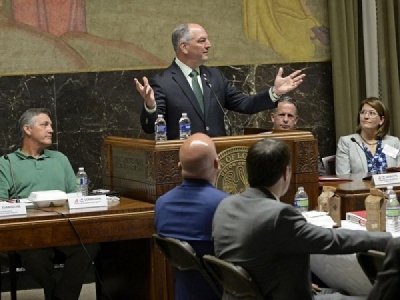
Posted on May 31, 2018
By Ben Myers, The Acadiana Advocate
Gov. John Bel Edwards on Tuesday announced the creation of the Council on Watershed Management, with the purpose of adopting regional approaches to flood mitigation and drainage planning.
Ultimately the idea is to focus scarce resources on reducing the level of floodwaters, as opposed to traditional hazard mitigation efforts, he said.
“What we can’t do is suffer flood after flood and think the answer is to go in and bear the inordinate expense of raising structures,” Edwards told the Acadiana Planning Commission at a special meeting Tuesday in the state capitol. “So how about if we lower the flood waters, and better manage that? It’s much cheaper at the end of the day and you are not disrupting people’s lives and businesses.”
The council, created with an executive order Tuesday and composed of officials representing several state agencies, will build on the Planning Commission’s efforts to pursue regional flood-control projects based on watershed patterns, Edwards said.
Edwards, as he as in the past, lauded Acadiana-area parish presidents for working through the Planning Commission after the 2016 flooding disaster that engulfed much of the state to divvy out $25 million in state-administered FEMA grants in a manner that transcends political boundaries.
But that spirit of collaboration could be tested with billions more in federal disaster funds pending, particularly with respect to the prospect of dredging the Vermilion River. The proposed project is potentially divisive, pitting some in Lafayette, where the river is shallowest, against those in Vermilion Parish who fear upriver dredging would increase their risk of flooding.
The Army Corps of Engineers has requested funding to dredge the river for the first time in two decades as part of $17.4 billion emergency supplemental funding appropriation, Col. Michael Clancy, commander of the New Orleans District of the U.S. Army Corps of Engineers, said Tuesday before the governor spoke.
The river is shallower than its authorized depth of 9 feet in much of Lafayette, and gets deeper as it runs through Vermilion, according to a 2017 Corps survey. Lafayette homeowners and volunteers with the local Sierra Club chapter have said the river is badly silted in, contributing to more frequent flooding.
But deepening the river could increase the rate of water flow, increasing downriver flooding exposure, Vermilion Parish President Kevin Sagrera said in an interview after the commission meeting. Part of the problem, Sagrera said, is that Vermilion Parish marshes, which provide natural detention, have been degraded with saltwater intrusion.
“The Vermilion River, to me, is at capacity,” Sagrera said. “When the water comes down, it’s got to come over the banks and go out into residential areas.”
The Corps’ Clancy, in an interview, said in an interview there should be no increased risk of downriver flooding so long as the river is dredged to its authorized depth, adding he will meet with Sagrera.
The projects to be funded with the supplemental appropriation have not been finalized, Clancy said, so it’s unclear how much of that money will come to Louisiana.
The Acadiana projects being funded with the $25 million in FEMA grants are mostly detention projects, with limited contributions to the ultimate goal of lowering the floodplain by one foot, as the commission’s chief executive, Monique Boulet, acknowledged Tuesday.
An extensive watershed modeling project needs to be completed first, she said, and one of the first steps to accomplishing that goal is installing a new network of river gauges that measure water flow and depth throughout the Vermilion River, Bayou Teche and Mermentau River watersheds. That will cost $2.4 million, with funding coming from the FEMA grant money.
That money is administered through the state, but the federal government still must approve that submitted projects are eligible for funding. Approval of the Acadiana projects is still pending.
The state is also set to receive $1.2 billion in disaster funding from the Department of Housing and Urban Development, and Edwards said that money will be spread around the state for projects aimed at lowering floodplains within watersheds, in line with the approach Acadiana leaders are attempting to take, once they receive HUD’s approval.
“You actually are ahead of the curve when it comes to how we allocate at least part of the additional dollars we are going to receive,” Edwards said at the meeting.
Source: The Acadiana Advocate





